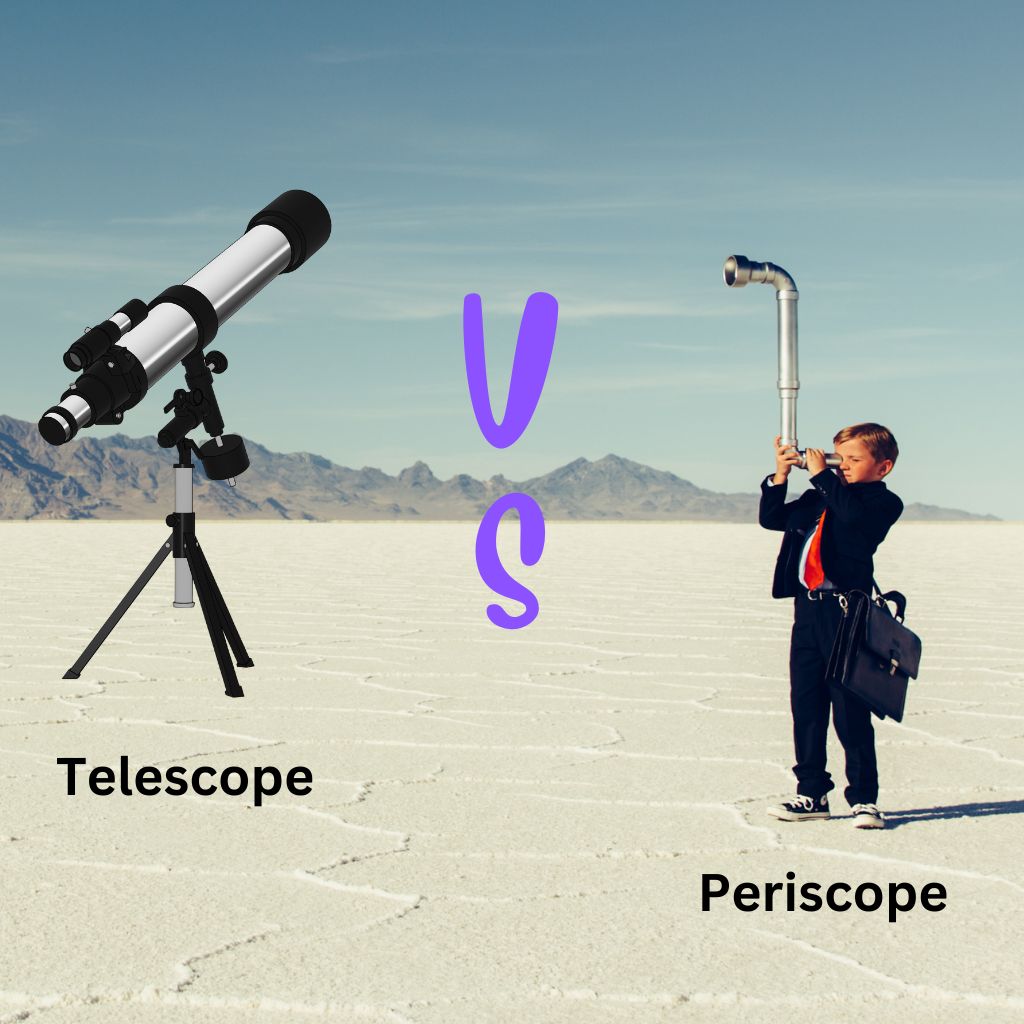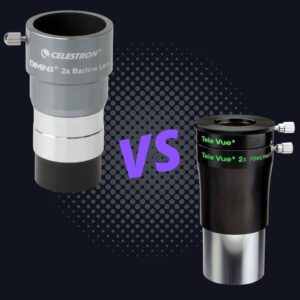This site contains affiliate links to products. I may receive a commission for purchases made through these links.
Telescopes and periscopes both magnify distant objects but they’re used in very different ways.
Telescopes are used by astronomers to gaze at the stars and planets. They’re designed to collect and focus light from far-off galaxies. On the other hand, periscopes are used to observe objects from a hidden position. They’re often found in submarines, allowing sailors to peek above the water without being seen.
So, whether you’re an aspiring astronomer or a budding submariner, understanding the difference between these two optical devices can be useful. Let’s dive in.
What is a Telescope?
A telescope is a fascinating tool that amplifies our vision. It’s like a superpower that allows us to scope distant cosmic wonders from our own backyard. Understanding how it works provides insight into its fantastic abilities.
The basic principle of a telescope is simple: it collects light. By gathering more light than our eyes can, telescopes provide a much brighter and clearer view of distant objects. Different types of telescopes accomplish this task differently, using either lenses or mirrors. In a Refracting Telescope, lenses bend or refract the light that comes in, forming it into an image. Reflecting Telescopes, on the other hand, use mirrors to reflect the incoming light and form an image.
Telescopes aren’t just used for stargazing. They’ve played vital roles in many scientific discoveries including revealing the planetary orbital patterns and spotting distant galaxies!
Types of Telescopes
Contrary to common belief, not all telescopes are created equal. They range in size, design, and functionality. Some of them are designed to observe specific types of celestial objects, such as nearby planets or distant galaxies. Let’s dive into some of the main types of telescopes:
- Refracting Telescopes: These are the classic telescopes most of us are familiar with. They use a series of lenses to refract light and enlarge distant objects. Known for their clarity, they are perfect for getting a closer view of the moon or other celestial bodies within our solar system.
- Reflecting Telescopes: Using mirrors instead of lenses, reflecting telescopes bounce light around inside the telescope to present you with an amplified image of distant celestial objects. These are widely used by astronomers due to their ability to provide views of deep-space phenomena.
- Radio Telescopes: These special types of telescopes detect radio waves from space rather than visible light. By capturing these waves, radio telescopes help us see beyond the limitations of optical telescopes.
Ultimately, the choice of a telescope depends on what an observer wishes to view and study. They’re not just tools of the trade for astronomers but they offer a limitless window into the grandeur of the cosmos for all who dare to gaze upon the stars.
How Telescopes Work
Telescopes operate on the fundamental principle of light collection; the bigger the light-collecting area, or ‘aperture’, the better the ability to detect faint light or details. They trap light from distant objects and amplify it, so our eyes can take stock of what’s beyond our average vision.
When it comes to refracting telescopes, they employ lenses to gather and focus light. The large objective lens at the front bends the incoming light rays into a single point of focus, often at the eyepiece. The eyepiece then magnifies that point, creating a larger image. Imagine seeing a distant ship on the edge of the horizon in crisp details; that’s the refracting telescope’s work!
Alternatively, reflecting telescopes use mirrors. The light enters the telescope and gets directed towards a primary mirror located at the back. This mirror, which is curved, reflects the light towards a secondary mirror that then aims it at the eyepiece. Reflecting telescopes can collect more light and tackle aberrations more effectively than their refracting counterparts.
Lastly, we have Radio telescopes which pick up radio waves from space. These aren’t regular telescopes, as they don’t directly create visual images. Instead, computers translate radio signals into images, granting us a different insight into the universe.
There’s a world of complexity hidden in these three simple explanations. Some telescopes are built upon combinations of these models. However, the objective remains the same — to collect and amplify light, opening up our view to the marvelous expanse that yonder space holds.
What is a Periscope?
Periscopes, much like telescopes, use a simple but effective system of mirrors or prisms strategically aligned to redirect light from one end of the instrument to the other. This mechanism allows users to view an area or object that might be out of direct sight.
Digging deeper, the key benefit of a periscope lies in its design. Its structure, typically a long tube with mirrored prisms at both ends, allows the evasion of obstacles. Think about it – in a submarine, one can look over the surface of water without being physically present there.
Interestingly, periscopes aren’t limited to nautical uses. In fact, many people are surprised to learn they’re found in some unexpected places. For instance, they’re integral in armored tanks and certain types of cameras. Even architects sometimes use them to gain different perspectives while drafting a structure’s design.
With the advancing technology, periscopes have evolved too. You’ll find them taking up roles in complex mechanisms such as laser-based systems and high-end military systems, often in conjunction with other optical instruments.
How Periscopes Work
Stepping away from outer space let’s bring our focus closer home to the mechanisms of periscopes. Used on submarines to sneak a peek at the world above water, these devices have a structure that’s captivating and clever in its simplicity.
At its core, a periscope includes two mirrors or prisms set parallel to each other at a 45-degree angle. This redirects the light path so you’re able to view objects not in your direct line of sight. When you look into the eyepiece of a periscope, the light from a distant object hits the top mirror, reflects at a right angle down to the mirror at the bottom, and then reflects right into your eye.
Sounds simple, right? It’s a basic concept, but the applications are far-reaching. I’ve mentioned uses in submarines, but you’ll also find periscopes in armored vehicles for viewing the field without exposing soldiers to danger. Architects use them to bring natural light into spaces that wouldn’t otherwise see the sun. The next time you snap a photo with your smartphone, thank the principles of a periscope. They ensure that light travels to the camera’s sensor no matter the object’s orientation.
I’d be remiss if I didn’t mention further advancements. While basic periscopes rely on mirrors, there’s also been a shift towards more complex and refined periscope technologies. Consider innovative, ultra-high-speed laser systems where mirrors won’t cut it. Here, you’ll find prisms used to bounce the light beam multiple times, maintaining its alignment while travelling at the speed of light.
And what about specialized periscope designs for military uses equipped with advanced features like infrared detectors and image stabilisation? These aren’t your basic light-bouncing devices anymore.
But we’ve only scratched the surface when it comes to periscopes. With the combination of mirrors and the bending of light, it shows how we’ve learned to command nature’s mechanisms to broaden our visual world. It’s worth contemplating as we prepare to delve deeper into the work of other optical devices.
Different Types of Periscopes
Let’s delve a bit deeper into the specifics of periscopes. Contrary to what some may think, all periscopes are not created equal. There are varying types that serve diverse purposes. We’ll focus on two primary kinds here: the traditional periscope and the non-penetrating periscope.
The traditional periscope, as used in submarines, is a tube with mirrors set at 45-degree angles to each other. One mirror captures the light from the object being viewed, and it’s bounced off the second mirror right into the viewer’s eyepiece. This classic design is both simple and effective but it has one main limitation: you can only see what’s directly in front of you.
Now let’s consider the non-penetrating periscope. This technology has transformed modern warfare, particularly in armored vehicles. Instead of having a periscope that needs to physically stick out from the vehicle – a serious safety hazard in combat – now they can sit safely in their vehicle with the periscope tucked away inside. The non-penetrating periscope uses complex mirrors and prisms to guide the view from outside. As a result, they gain a 360-degree unobstructed view, exponentially improving their situational awareness.
In addition to these, periscopes also come in specialized designs for exclusive use. There are periscopes that use prisms instead of mirrors for a higher definition view. Others are designed for laser systems, enhancing their focus and reducing energy loss.
Just for a quick comparison, here’s a markdown table to summarize the mentioned points:
| Periscope Type | Description | Usage |
|---|---|---|
| Traditional Periscope | Uses mirrors at 45-degree angles | Submarines |
| Non-penetrating Periscope | Complex system of mirrors and prisms | Modern Warfare |
| Specialized Periscope | Adopting prisms instead of mirrors, used in laser systems | High-Definition Viewing, Laser Systems |
Conclusion: Telescope vs periscope
So there you have it. Periscopes aren’t just for submarines anymore. From transportation to warfare and even entertainment, they’ve truly broadened their horizons. Advancements in technology have only added to their appeal, with complex mirrors and prisms enhancing the viewing experience.
It’s clear that the versatility of periscopes is unmatched, their influence reaching far and wide across various industries. They’ve certainly come a long way and it’s exciting to see where they’ll go next. As for telescopes, while they’ve always been our window to the cosmos, it’s evident that periscopes are steadily carving out a niche for themselves right here on Earth.






